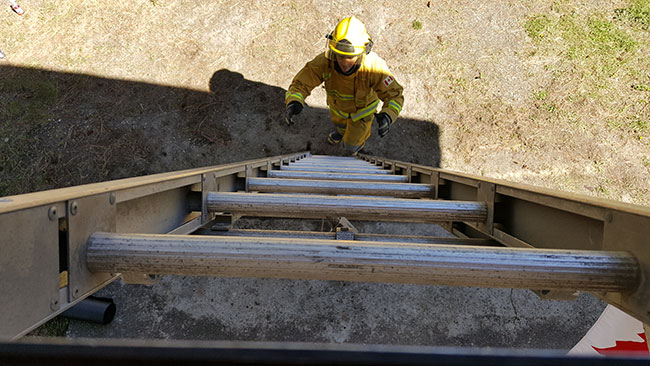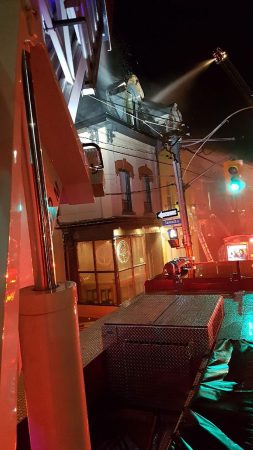
Features
Back to Basics: Ladder dating
February 4, 2020
By Mark van der Feyst
 As a fire service, we need to be able to operate ground ladders with just one firefighter due to the consistent deficiency that we all face, which is a lack of manpower on the fire ground.
Photos by Mark van der Feyst
As a fire service, we need to be able to operate ground ladders with just one firefighter due to the consistent deficiency that we all face, which is a lack of manpower on the fire ground.
Photos by Mark van der Feyst
We have begun a new year, and along with this we are going to begin a new series with the Back to Basics column called Ladder Dating. Ladder Dating will be an in-depth look at ground ladder operations for the firefighter.
Why call it Ladder Dating? A little background on this – while teaching at a conference in Nova Scotia last year, a few of us were leading a hands-on training class and the topic of ground ladders came up. While we were answering the questions from the students, a reply that I gave to one of them was “you need to know your ground ladder just like you need to know your spouse. Before you got married, you dated each other for a long time and got to know each other – the same thing needs to happen with you and the ground ladder. You need to date it!”
After class, we were joking around about what I had said – “you need to date your ground ladder” – which spawned Ladder Dating. As funny or strange as this may sound, there is much truth to it for the firefighter; they, we, you, need to know your ground ladder just like you need to know your significant other. The ground ladder is one of those forgotten tools on the fire ground and the training ground, and it needs to be one of those tools that every firefighter must be familiar with and use.
For those that are married or about to get married, think about the time when you were dating your special someone. You asked questions about their life, got to know what things they really liked and disliked, got to know their mannerisms, how they felt when you held them, what it took to get them into a happy mood and so on.

The primary reason why we use ground ladders is for rescue — rescue of the occupants and rescue of the firefighter.
When we use the term Ladder Dating, we are referring to the same exact thing – getting to know the ground ladder very intimately, so much so, that when it comes time to use the ground ladder, it is effortless for the firefighter who will be using efficient and effective actions.
We can see in history how the ground ladder has performed well for rescues. On Sept. 23, 2019, seven rescues/grabs were made during a 3-alarm fire at a nursing home in Lehigh County, Pa. Seven individual occupants were pulled out of the burning structure using a ground ladder! There are many more examples just like this one, where multiple rescues have been made from one, two and/or three firefighters all armed with a ground ladder.
The ground ladder is a useful tool for the fire ground. It allows us to perform rescues from elevated positions, gain access to the roof for ventilation purposes, gives firefighters an egress path out a window for survival and gives the RIT team an ingress path to rescue a downed firefighter. The primary reason why we use ground ladders is for rescue — rescue of the occupants and rescue of the firefighter.
In basic training, we instruct ground ladders with the use of two firefighters because that is what the textbook shows us and calls for with skills development and sign-offs. Even though there are sign-offs for single firefighter carries, raises and operations, we as a fire service tend to lean toward using two firefighters for everything. In many departmental operations, a team of two will be assigned to operate a ground ladder on the fire ground. The fire service likes to use two firefighters when operating ground ladders.
I highlight this tendency because we are going to look at ground ladders, or Ladder Dating, from a single firefighter perspective as opposed to a two-person team. As a fire service, we need to be able to operate ground ladders with just one firefighter due to the consistent deficiency that we all face, which is a lack of manpower on the fire ground. There are very few departments in Canada that can claim to have an abundance of firefighters on the fire ground to deal with a residential structure fire compared to the vast majority of departments who face a shortfall of firefighters when responding to the same residential structure fire.
Due to the lack of manpower available for most departments, firefighters need to become efficient and effective with their actions and operations. One starting point is with single firefighter tasks on the fire ground and this includes ground ladders. For a firefighter to be effective and efficient, they need to become experts with their equipment, know their equipment’s limitations, know each piece of equipment intimately just like they know their significant other! This is where Ladder Dating comes into play.
In the following columns in the months to come, we will look at items such as balance points, ladder lengths, the weight and feel of the ground ladder, one firefighter high shoulder carry and raise, the halyard, ladder tip positioning, when to use two firefighters, working on the ladder, climbing angles, getting on and off the ladder, extension limitations of the ladder, as well as limitations of the ladder.
Every fire truck manufactured to NFPA specifications will come with two ground ladders, usually a 14-ft roof ladder and a 24-ft extension ladder, as well as an attic ladder. So, no matter what type of fire truck you operate on or respond with, you will have the opportunity and ability to grab and operate a ground ladder for whatever purpose it may be needed for. Get ready for Ladder Dating!
Mark van der Feyst has been a member of the fire service since 1999 and is a full-time firefighter in Ontario. Mark teaches in Canada, United States and India, and is a FDIC instructor. He is the lead author of the Residential Fire Rescue book. ContactMark at Mark@FireStarTraining.com.
Print this page